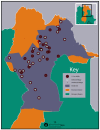A randomized longitudinal factorial design to assess malaria vector control and disease management interventions in rural Tanzania
- PMID: 24840349
- PMCID: PMC4053883
- DOI: 10.3390/ijerph110505317
A randomized longitudinal factorial design to assess malaria vector control and disease management interventions in rural Tanzania
Erratum in
- Int J Environ Res Public Health. 2014 Sep;11(9):8622-3
Abstract
The optimization of malaria control strategies is complicated by constraints posed by local health systems, infrastructure, limited resources, and the complex interactions between infection, disease, and treatment. The purpose of this paper is to describe the protocol of a randomized factorial study designed to address this research gap. This project will evaluate two malaria control interventions in Mvomero District, Tanzania: (1) a disease management strategy involving early detection and treatment by community health workers using rapid diagnostic technology; and (2) vector control through community-supported larviciding. Six study villages were assigned to each of four groups (control, early detection and treatment, larviciding, and early detection and treatment plus larviciding). The primary endpoint of interest was change in malaria infection prevalence across the intervention groups measured during annual longitudinal cross-sectional surveys. Recurring entomological surveying, household surveying, and focus group discussions will provide additional valuable insights. At baseline, 962 households across all 24 villages participated in a household survey; 2,884 members from 720 of these households participated in subsequent malariometric surveying. The study design will allow us to estimate the effect sizes of different intervention mixtures. Careful documentation of our study protocol may also serve other researchers designing field-based intervention trials.
Figures
References
-
- World Malaria Report 2013. World Health Organization; Geneva, Switzerland: 2013.
-
- MoHSW . In: Medium Term Malaria Strategic Plan, 2008–2013. Ministry of Health and Social Welfare, editor. Ministry of Health and Social Welfare; Dar es Salaam, Tanzania: 2008.
-
- Gallup J.L., Sachs J.D. The economic burden of malaria. Amer. J. Trop. Med. Hyg. 2001;64:85–96. - PubMed
-
- Coleman P.G., Morel C., Shillcutt S., Goodman C., Mills A.J. A threshold analysis of the cost-effectiveness of artemisinin-based combination therapies in sub-Saharan Africa. Amer. J. Trop. Med. Hyg. 2004;71:196–204. - PubMed
-
- Fowler V.G., Lemnge M., Irare S.G., Malecela E., Mhina J., Mtui S., Mashaka M., Mtoi R. Efficacy of chloroquine on plasmodium falciparum transmitted at Amani, eastern Usambara Mountains, north-east Tanzania: An area where malaria has recently become endemic. J. Trop. Med. Hyg. 1993;96:337–345. - PubMed
Publication types
MeSH terms
Substances
Grants and funding
LinkOut - more resources
Full Text Sources
Other Literature Sources
Medical
Miscellaneous





